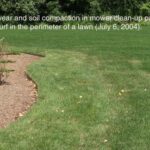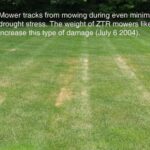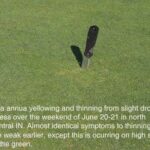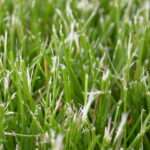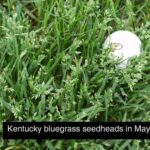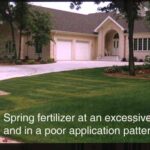Homeowner
Rust Revival!
Well it must be September and it must finally be dry because I have seen some serious outbreaks of rust on many perennial ryegrass lawns throughout the area over the past week. Leaf rust has been most noticeable on lawns that are newly planted and malnourished, both excellent conditions favoring the development of this turf […]
Turf 101: Why does September Fertilization of Cool-Season Grasses Work?
Normal growth patterns of cool season grass produce most leaf growth in the spring. Therefore fertilization in spring tends to stimulate even more leaf growth which may in turn decrease long-term stress tolerance in the summer months. On the other hand, cool season grasses tend to slow down leaf growth in the fall producing relatively […]
September is a Crucial Time to Fertilize All Cool-Season Turfs
Early to mid-September is the most important time to fertilize cool-season turfgrasses like creeping bentgrass, Kentucky bluegrass, perennial ryegrass, and tall or fine fescue. September fertilization is crucial on all turf areas regardless if it is a lawn, athletic field, or golf course green, tee or fairway. Fertilization in mid-September encourages the production of new […]
Seed Now!
We’re still in the middle of the optimum seeding window for cool-season turfgrasses. The optimum time to seed cool-season turfgrasses is between Aug. 15 and Sept. 15 in central IN, a week earlier in northern IN, and a week or so later in southern IN. It is important to seed as earlier as you can […]
Rust in Turf
The rain and temperatures this year have favored excellent turfgrass growth, and the N applied this spring is being depleted, thus favoring rust in even regularly fertilized turf areas. Rust symptoms are reddish-orange lesions or spots on the leaf blades and a rust-colored powder that you can rub off with your fingers. Rust will rarely […]
Turf Field Day Held July 27
Thanks to everyone who attended and helped make the 2004 Midwest Regional Turf Field Day a success on Tuesday, July 27. A clear day with temperatures in the 70’s was almost perfect for the nearly 700 attendees. Attendees had the opportunity to view the latest in turfgrass research, visit with Purdue specialists, see the most […]
Thinning Turf Around Lawn Perimeter from zero-turning radius mowers
The popularity of the new zero-turning radius mowers is well-justified in terms of time and energy saving devices. However, these mowers are much heavier and faster than walk-behind mowers and thus increase compaction and turf wear. This is especially important around the perimeter of lawns (commonly referred to as the clean-up passes) where the mower […]
Brown Tracks in Lawn
I’ve seen lawns and heard this week about brown streaks that are about the width of the mower (photo). In the vast majority of the cases, these tracks are caused by the weight of a mower traversing across a portion of the lawn that was drought-stressed. Drought stress may not have been easily visible before […]
News about Japanese beetles is mostly bad!
Japanese beetles are back! They appeared 10 days to 2 weeks earlier than normal this year and indications are pointing to a very heavy population in many parts of the state. Last years weather conditions kept soils moist which apparently led to a very successful grub hatch. Early emergence usually points to a somewhat earlier […]
Finicky Poa annua Yellowing and Thinning on Greens
In spite of the cool and dry weather, Poa annua continues to yellow and sometimes thin on golf greens. Last week Poa annua was thinning and dieing in low areas from too much water, heat, and humidity (photo). However, the cool dry weather over the weekend allowed for maximum water loss through evapotranspiration. Plus since many irrigation systems were […]
Time to consider a change…?
We are finally getting near the end of the spring growth flush for our major cool-season lawngrass species like Kentucky bluegrass, ryegrass and tall fescue. With a little help from mother-nature, hopefully mowing will be more manageable from here on out. During the past few weeks you may have noticed a decline in overall appearance […]
Bumper Crop of Seedheads This Year
Cool-season turfgrasses such as Kentucky bluegrass and perennial ryegrass are now producing seedheads. This natural phenomenon is induced by daylength, but the intensity of seedhead production is affected primarily by temperature and is likely the cause of the above average seedhead production this year. Seedheads detract from the appearance of a lawn because they grow […]
May Fertilizer
As turfgrass growth is beginning to slow, it’s time to consider fertilizing your lawn. Applying fertilizer now should not increase vertical growth dramatically as long as moderate rates of nitrogen are used and will help your lawn retain it’s color and health. Apply 0.75 to 1.0 lbs. N/1000 sq. ft. with a product that contains […]
Prevention of Dog Urine Spots
We have received a ton of questions on dog urine spots this year, probably because it has been a very dry April. Dog urine will burn leaf blades because the high concentration of salts in the urine will pull water out of the leaf dehydrating the leaf. This problem is exaggerated by warm and/or dry […]
Seeding Lawns Around New Construction
Have you just moved into a new house with no lawn? Resist the urge to grade and quickly seed or sod this spring. The reason for this is that the soil must settle or be compacted after grading. Each foot of soil moved could settle up to two inches resulting in a rough lawn in […]
If You Must Seed, Do it Now
Late summer is the best time to seed, but sometimes turf must be seeded in the spring. The following points should help improve the success of spring seedings: Seed as soon as possible (now is not too early) so the seed is in the ground and ready to germinate as soon as the soil temperatures […]
Bumpy Lawn?
Lawn seem bumpier this spring when you first mowed it? Bumpy, difficult-to-mow lawns can be caused by either above-ground factors or below-ground soil factors. If the bumpiness is due to patches of incompatible species of coarse, bunch grasses like tall fescue or orchardgrass growing in a stand of predominantly Kentucky bluegrass or perennial ryegrass, apply […]
Calculating the pounds of fertilizer to apply
There are literally thousands of fertilizers and fertilizer/pesticide combinations available to homeowners and professionals. Therefore, we can’t recommend how many pounds of fertilizer to apply, but rather we must recommend fertilization rates in pounds of nitrogen per thousand square feet or lbs N/1000ft 2 . Calculating the amount of fertilizer to purchase and apply is […]
Why we don’t recommend specific fertilizer/herbicide combinations for homeowners
We’ve received a number of emails asking for specific product recommendations for XYZ town in IN or IL, or even as far away as NY. Its very difficult, OK impossible, for us to recommend specific fertilizer/herbicide combinations because there is a large number of brands and an even larger number of fertilizer/herbicide combinations available on […]
Spring N: Do-It-Yourselfers vs Professional Recommendations
We recommend waiting until mid-May to fertilize for the vast majority of do-it-yourselfers, while professional lawn care operators often apply fertilizer early in the spring with the preemergence herbicide. These two seem to contradict each other. We know that a very low rate of N applied in the spring will green up the turf quickly […]

